A Oracle SOA Suite and Oracle Business Process Management Suite Installation Screens
This appendix contains screenshots and descriptions for all of the Oracle SOA Suite and Oracle Business Process Management Suite installation screens:
A.1 Specify Inventory Directory
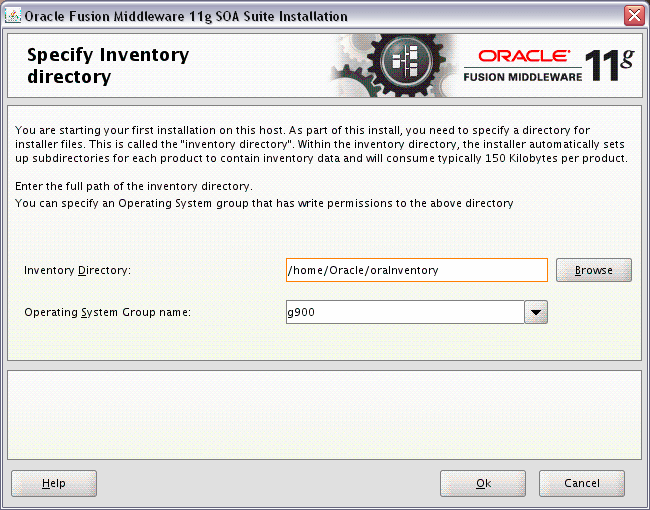
Description of the illustration install_inventory.gif
If this is your first Oracle installation on a host that is running UNIX or Linux system software, you must use this screen to specify the location of the Oracle inventory directory.
The inventory directory is used by the installer to keep track of all Oracle products installed on the computer.
The following table describes the fields on this page.
| Field | Description |
|---|---|
|
Inventory Directory |
Use this field to identify the complete path for the new Oracle inventory directory that will be created. By default, the installer assumes you will create the Oracle inventory in a directory, based on the following environment variable and path: $USER_HOME/oraInventory If this location is not appropriate for your environment, enter a new path for the location of the inventory directory. Note that the inventory directory will eventually contain many files, including log files for each Oracle software installation you perform on this machine. |
|
Operating System Group Name |
From the Operating System Group drop-down menu, select the group whose members you want to grant access to the inventory directory; all members of this group will be able to install products on this machine. |
A.2 Inventory Location Confirmation
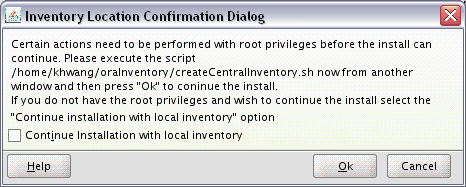
Description of the illustration install_inventory_confirm.gif
This dialog box appears only on UNIX systems. It prompts you to run a shell script that will create the Oracle inventory in the location you specified on the Inventory Location screen.
You must have root privileges to run the script.
If you do not have root privileges, but you want to continue with the installation, select Continue Installation with Local Inventory.
Note that the preferred method of managing your Oracle installations is to create a central inventory directory with the shell script. If you create a central inventory directory, then the next time you install any Oracle software on this machine, the installer will automatically locate and update the inventory without prompting you. The installer uses the inventory to identify what Oracle software is installed. It also saves all your installation log files to the inventory location.
If you do not run the script and use a local inventory, a local copy of the inventory is created for this specific installation only. If you later run the installer to install additional Oracle software, the installer will again prompt you to create an inventory.
A.3 Welcome
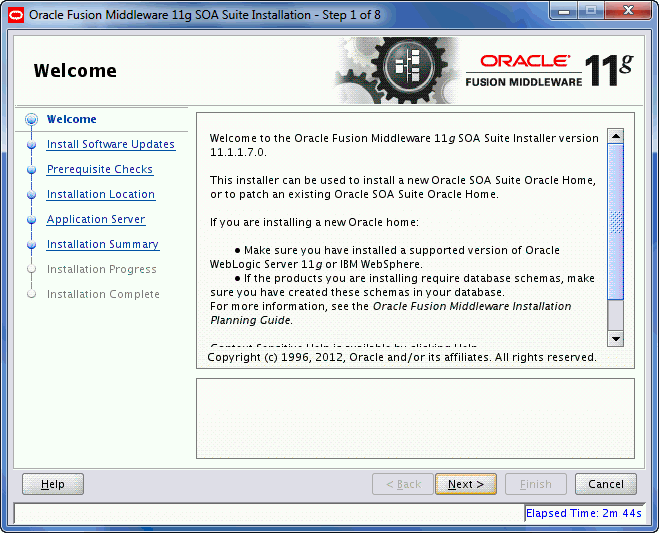
Description of the illustration install_welcome.gif
This page introduces you to the Oracle Fusion Middleware installer and provides two important pieces of information:
-
A navigation pane on the left that summarizes the tasks the installer will help you complete. Each item in the navigation pane represents a specific installer screen that will prompt you for information required to install the software.
-
Information about any prerequisites you might need to perform before continuing with the installation.
Review the information on this screen carefully to be sure you have performed all the necessary prerequisites.
If you are not sure about any of the prerequisite tasks, refer to the Oracle Fusion Middleware Installation Planning Guide, as well as the installation guide for the specific Oracle Fusion Middleware software you are about to install.
A.4 Install Software Updates
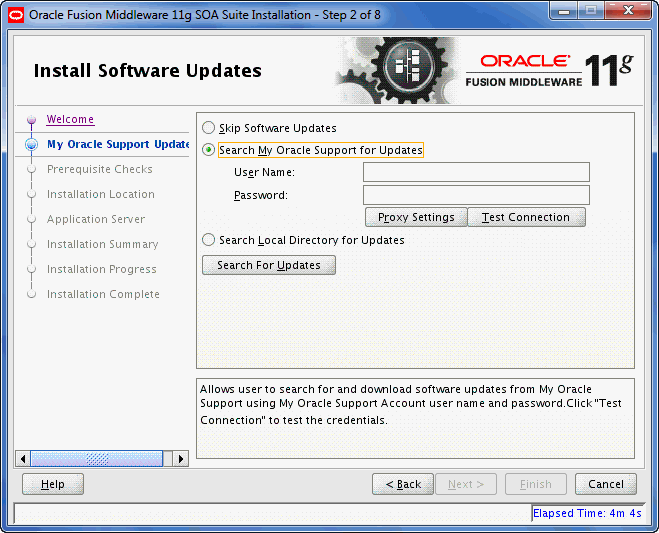
Description of the illustration install_software_updates.gif
Use this screen to quickly and easily search for the latest software updates, including important security updates, via your My Oracle Support account.
The following table describes the fields on this screen.
| Element | Description |
|---|---|
|
Skip Software Updates |
Select this option to skip this screen. The installer will not check for updates that might be applicable to the current product installation. |
|
Search My Oracle Support for Updates |
If you have a My Oracle Support account, then select this option to have the installer automatically search My Oracle Support for software updates that apply to the software products are about to install. Enter your My Oracle Support account name and password, and then click Search for Updates. The installer automatically downloads applicable software updates from My Oracle Support. Before you search for update, you can test your login credentials and the connection to My Oracle Support by clicking Test Connection. Click Proxy Settings to configure a proxy server if one is required. |
|
Search Local Directory for Updates |
Select this option if you already downloaded the latest software updates and you want the installer to search a local directory for updates applicable to the products you are about to install. When you select this option, the installer displays an additional field and Browse button that you can use to identify the local directory where your updates are located. |
A.5 Prerequisite Checks
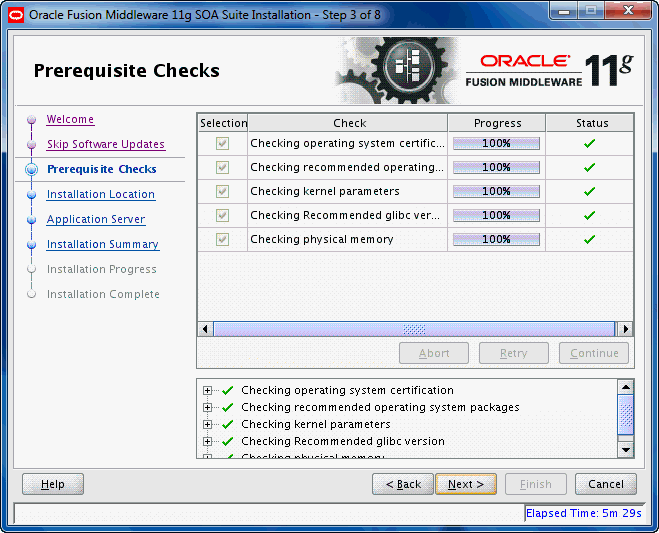
Description of the illustration install_prereq_check.gif
This screen analyzes the host computer to ensure that specific operating system prerequisites have been met.
If any of the prerequisite checks fail, then a short error message appears in the bottom portion of the screen. Fix the error and click Retry to try again. If you want to ignore the error or warning messages and continue with the installation, click Continue.
Click Abort to stop prerequisite checking for all components.
A.6 Specify Installation Location
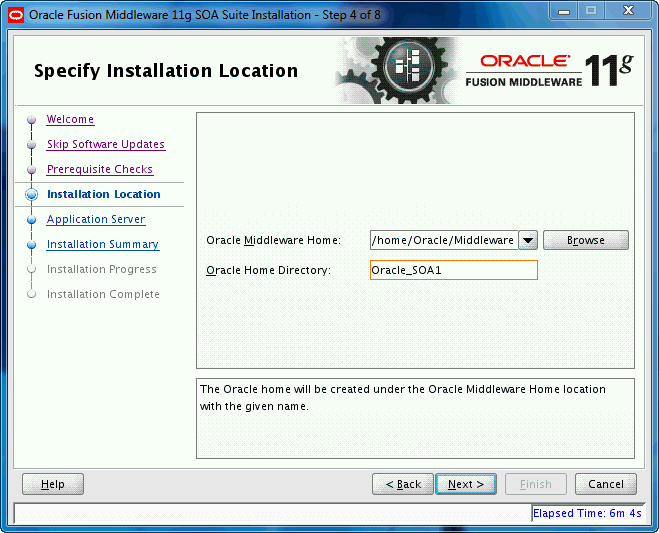
Description of the illustration install_location.gif
Use this screen to identify where you want to install your Oracle Fusion Middleware software.
The following table describes the fields that appear on this page.
| Field | Description |
|---|---|
|
Oracle Middleware Home |
Use this field to specify the location of your Oracle Middleware home directory:
|
|
Oracle Home Directory |
Use this field to specify the directory inside the Middleware home where you want to install your products. If you specify a directory that already exists, it must be either:
If you specify a new directory, it will be created inside the Middleware home. |
Note:
For the remainder of this document, the directory specified in the Oracle Home Directory field will be referred to as your SOA Oracle home to avoid any confusion with the Oracle home directories of other Oracle Fusion Middleware products.
For more information about the Oracle home and Middleware home directories, refer to "Oracle Fusion Middleware Directory Structure" in Oracle Fusion Middleware Installation Planning Guide.
If you are performing an installation on a Windows operating system, be sure that your directory paths are valid and do not contain double backslashes (\\).
A.7 Application Server
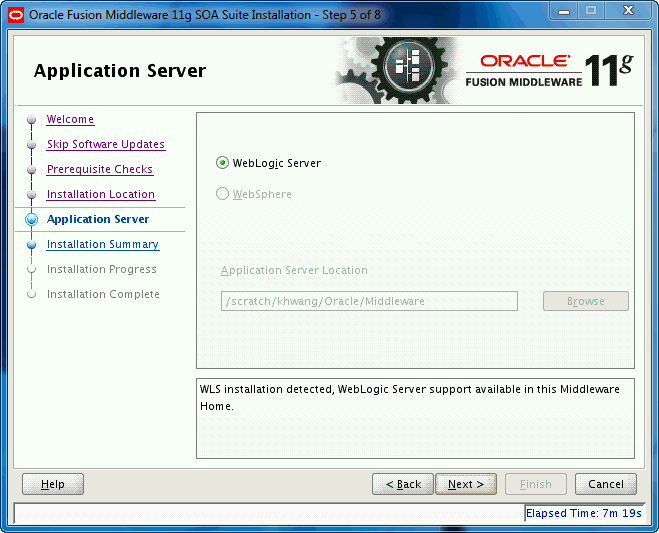
Description of the illustration install_app_server.gif
Use this screen to select the application server you want to use for this installation.
-
If the installer detects a Middleware home with Oracle WebLogic Server installed, then this is the application server that will be used. All other fields in this screen will be inactive.
-
If the installer detects a Middleware home without an Oracle WebLogic Server installed, you must select one of the application server options and then provide its location in the Application Server Location field.
-
If the installer does not detect a Middleware home directory, the "WebLogic Server" option will be inactive. You must select "WebSphere" and then provide the location of your IBM WebSphere in the Application Server Location field.
A.8 Installation Summary

Description of the illustration install_summary.gif
This screen summarizes the selections you have made during this installation session. It includes the following information:
-
The location of your installation
-
How much disk space will be used for the installation
-
The applications you have selected for installation
Review information on this screen carefully, and take one of the following actions:
-
If you want to make any changes to the configuration before starting the installation, use the navigation pane to select the Installer screen you want to return to and edit.
-
If you are satisfied with the information, click Install to begin the installation procedure.
-
If you want to save this configuration to a text file (called a response file), click Save. The resulting response file can be used later if you choose to perform the same installation from the command line. See Appendix C, "Silent Installation and Deinstallation" for more information.
A.9 Installation Progress
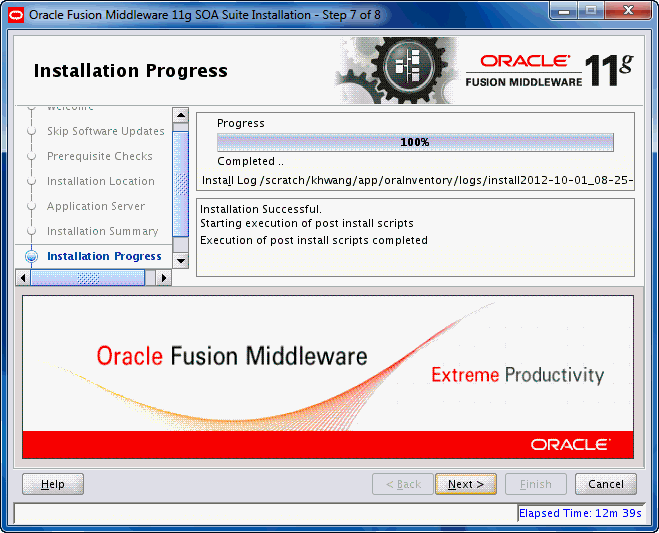
Description of the illustration install_progress.gif
This screen shows you the progress of the installation.
If you want to quit before the installation is completed, click Cancel. Doing so will result in a partial installation; the portion of the software that was installed on your system before you click Cancel will remain on your system, and you will have to remove it manually.
A.10 Installation Complete
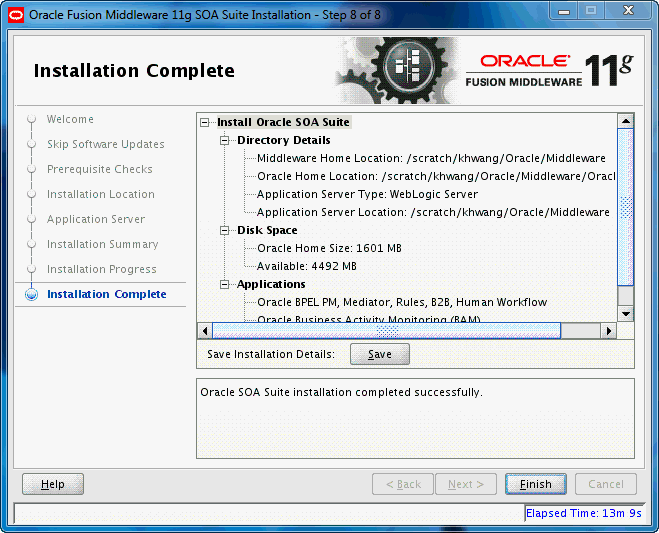
Description of the illustration install_complete.gif
This screen summarizes the installation that was just completed.
If you want to save this summary information to a text file for future reference, click Save.
Click Finish to dismiss the screen.